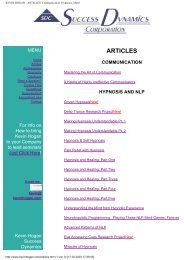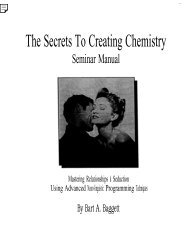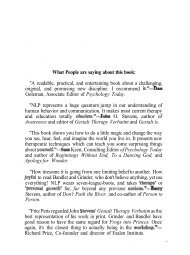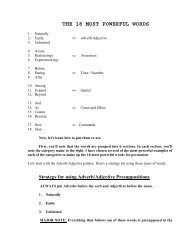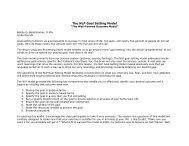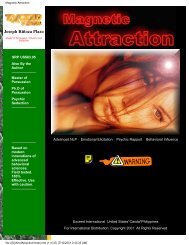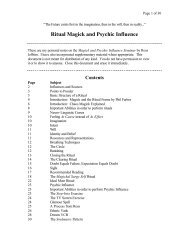A Pragmatic Guide To Communication & Change.pdf - NLP Info Centre
A Pragmatic Guide To Communication & Change.pdf - NLP Info Centre
A Pragmatic Guide To Communication & Change.pdf - NLP Info Centre
- No tags were found...
You also want an ePaper? Increase the reach of your titles
YUMPU automatically turns print PDFs into web optimized ePapers that Google loves.
Paradox and Coanlerparadox. What she and her team of researchers discovered working<br />
with schizophrenic families was that appearance is not necessarily a valid indication of<br />
the meaning of a behavior. They write:<br />
for example, if a patient appeared to be sad, we concluded he tuns sad, and we went<br />
so far as to try to understand tuhy he was sad, inviting and encouraging him to speak<br />
to Is about his sadness.<br />
71<br />
69<br />
With these changes came the birth<br />
ofciviliaation, law and order, the development<br />
of philosophical and oral systems and the<br />
growth of mathematics and the sciences. As<br />
knowledge and communication in<br />
ased, people hogs, to live out highly<br />
specialized social roles, carrying the sense of<br />
separation and alienation from nature to its<br />
extreme. (p. 12-13)<br />
CHAPTER III THE META MODEL<br />
If he is indeed wise ]the teacher] does not bid you enter the house of his wisdom,<br />
but rather leads you to the threshold of your own mind.<br />
Kahlill Gibran The Prophet<br />
The Digital Representational System<br />
Symbolic Representation<br />
The digital system, language, is the symbolic representation of experience. It is the only<br />
system which can represent all the other representational systems as well as being able to<br />
represent itself. Not directly related to any of our sensory organs, it is so unique that it<br />
warrants special attention. The historical importance of this system is discussed by<br />
Samuels and Samuels in their book Seeing with the Mind's Eye. As they put it:<br />
With the development of language and a written system for recording it, rational<br />
thought came to dominate. Words came to function as labels, allowing man to<br />
detach himself from his experience and analyze it....<br />
Such a powerful tool, the digital system! As with the other systems, it is not only an<br />
indicator of how a person creates his model of the world, but it also serves to enhance as<br />
well as limit perception. The discussion of social constraints (Chapter 1) described how<br />
our ability to name something affects how we perceive it. In one example, the Eskimos'<br />
ability to name over seventy different kinds of snow was shown to be very important to<br />
their survival in the harsh northern climates. Only with their specific linguistic (digital)<br />
background is it possible to perceive the variations in the quality of snow indicated by<br />
their vocabulary.<br />
Built into the encoding element of our linguistic processes is what we might call a<br />
perceptual enhancer. Once a linguistic symbol has been assigned to a specific experience,<br />
it becomes a discrete, manipulatable element that is differentiated from the surrounding<br />
environment or experience. The powerful effect of language is discussed by the general<br />
semanticist J. Samuel Bois in his book The Art of Awareness. He says on page 19:<br />
We see the world through the meshes of that human-made filter; we project on the



